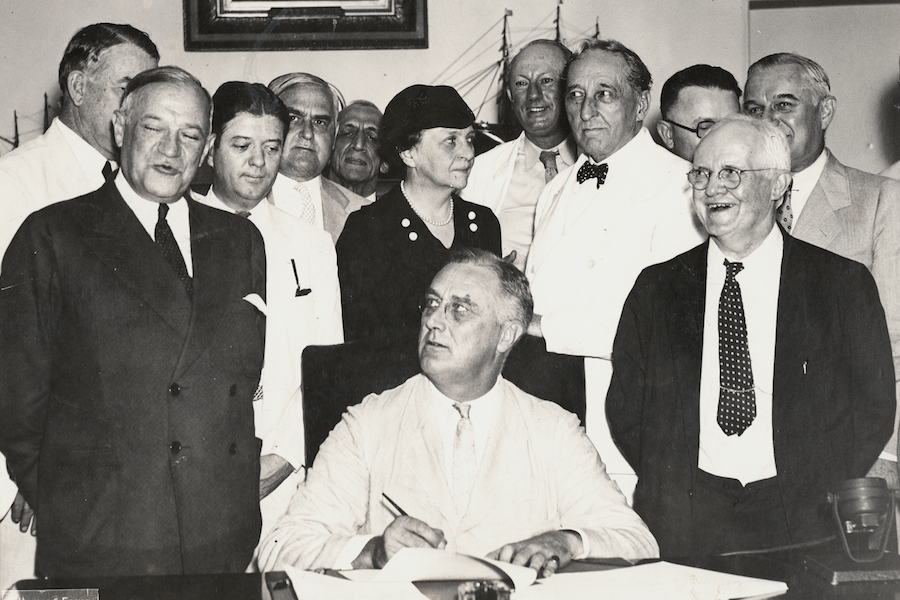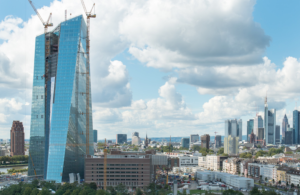President Franklin D. Roosevelt’s policies allowed the United States to avoid the perils of right-wing populism that plunged Europe into war in the 1930s — Europe should learn from his example
It is like a cruel remake: First came globalization with its ensuing golden years; then the crash followed resulting in the crisis of confidence and unbridled popular rage —until eventually, almost everywhere, right-wing Pied Pipers emerged to challenge for power. This happened in the 1920s and ’30s following the great financial crisis, and the pattern appears to be repeating itself today: First came the “party years”, then the crash — however, with one distinctive difference since Election Tuesday: Unlike the European crises of 80 years ago, this time even the USA has been seized with a frightful political shock.
Given these developments, the following question comes to mind: What had the Americans done better in the past — in particular what had former President Franklin D. Roosevelt done better in a comparable historical situation? Elucidating this question could help us understand what went wrong this time. More importantly, it could help us to recognize what the Europeans should hasten to learn without delay, before a similar disaster unfolds (again!) on their continent.
Perhaps better sooner than later, Europe needs a New Deal on the scale employed by Roosevelt to counteract crises, enraged citizens, and fears of an economic crash. A bit of stability masochism and pension cosmetics à la Schäuble, Nahles and Merkel will hardly suffice to stop the rising demagogues.
Crisis averted, but its underlying causes remain
At first sight, the notion that Roosevelt should be useful as a role model may seem odd. After all, this time around, central bankers and finance ministers in the US prevailed in what Roosevelt failed to achieve in his time: Preventing an extended period of enormously high unemployment after the crash, be it through low interest rates or through enormous economic stimulus packages. In fact, this time the depression did not materialize; moreover, the registered rate of unemployment dropped much faster than in Europe.
The hitch: All these measures did, in fact, avert the imminently threatening escalation of the crisis; however, its underlying causes were not resolved. In all likelihood they are to be found in the dramatic consequences of a unbridled period of globalization as was the case in the years prior to the crisis of the nineteen-thirties: In a similarly dramatic wealth divide into losers that appear similarly forlorn with similar subjective fears of social decline and similar anger at the elites; versus similarly aloof banks and ruling politicians appearing similarly helpless in the face of the crisis.
Treacherous collateral effect: That the central bankers managed to avert the collapse through injecting a great amount of capital into the economy even reinforced one or the other absurdity of some of the measures taken. For instance, the banks saved by the frequently cited taxpayers were the very ones that had played a decisive role in bringing about the debacle in the first place. This has generated even more rage. For instance, those benefiting from rescue operations by means of lower interest rates and rising prices are stockholders. They generally do not belong to the core group of the society’s losers.
Roosevelt supported and reimbursed the losers
This may be one crucial factor why this time the Americans have decided for Trump (with about half of his voters wanting him without reservation); and why, in his time, Democrat Roosevelt was able to remain in office over three presidential terms even in a far more desperate economic situation, with an unemployment rate sometimes of 25 per cent.
Roosevelt’s trick? Although his performance was less successful by comparison in terms of rescuing the economy, throughout his three boosts of the New Deal he never missed an opportunity to support and to make amends to the (true) losers of the crisis, and to establish the prospect of a better future (or at least to maintain hope for the future).
In the first deal, from 1933 onwards, 3 million workers were employed over a period of ten years to reforest woodlands, to build dams, and to repair roads and railways. Financial support was paid to farmers suffering under price deterioration as dairy farmers do today. Money was also spent on teaching and construction jobs, as well as on electricity plants in order to provide electricity to even the remote regions of the country.
In 1935, Roosevelt pushed further ahead by means of similar programs and new job projects, introducing new legislation for the protection of workers and through new social legislation.
Part three followed from 1937 onwards with new additions: A minimum wage, further job programs, further social security measures, and a long list of initiatives.
In other words, a program that would long ago have prompted this country’s industrial representatives to threaten to relocate all production facilities to Mars (as China is not a good option presently), if those representatives were not already in hospital with symptoms of cardiac arrhythmia.
The dogma of the free market and its consequences
Already, a few years ago, experts affiliated with economic historian Barry Eichengreen tried to analyze the reasons why in the 1930s some countries drifted into right-wing extremism while others did not. The scope of a country’s democratic experience was found to be one relevant factor. In the US in the year 2016, this factor cannot have been lacking. With regard to democracy, the Americans are seniors with a seat in the Council of Elders. Rather, economic factors were said to be of greater relevance.
There is hardly any other country in which the side effects of three decades of globalization have been felt so strongly; in which the real income of the middle class has fallen so clearly for a quarter century; and in which the differences between the super rich and the rest of the country have grown as dramatically as they have in precisely the two top capitalist-friendly countries of Reagan and Thatcher: In 2016, through Brexit and Trump, the established political systems of the US and Great Britain are now experiencing the greatest of shocks. A coincidence? Scarcely anywhere else has the dogma of the free market brought about so much implosion of industry as it has for the British and the Americans – nowhere was it more frowned upon by ultra-capitalist supporters to help the losers.
Nevertheless, there is little to suggest that the trend will exclude the continental Europeans: The situation is not really better in France or Italy. The next shock may very well occur in France, next spring, if the extreme right Front National party of Marine Le Pen wins the presidency.
We need a European New Deal
In purely economic terms, Roosevelt’s program did not create a paradise at all. It took years before the aftermath of the Great Depression had been overcome. Instead, as the President he so convincingly conveyed his staccato of measures with a determination to put an end to the insanity of a slipped globalization and financial liberalization that this was enough to convince people not to turn to right-wing populists. And after a fatal crisis, the impression arose that politicians have control of destiny.
If this is true, it is high time that the Europeans take action now and design a New Deal as spectacular as the one Roosevelt once provided for the US — for those who have been left by the wayside, and for a really substantial investment push. There is nothing wrong with occasionally switching roles for the sake of making improvements.
Otherwise, the next political shocks could soon come from France and Italy and, who knows, maybe from Germany. Time is running out.
Translated from German. Originally published at Spiegel Online on 11 November 2016






